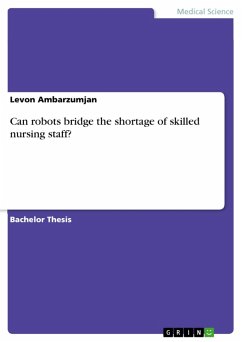Bachelor Thesis from the year 2019 in the subject Health - Nursing Science - Nursing crisis, , language: English, abstract: The shortage of nursing professionals is regularly discussed by politicians and the public. Due to the growing workload for nurses and poor pay, the nursing profession has lost much of its appeal. At the same time, demographic change is ensuring that the number of people in need of care is steadily increasing. By 2030, Germany is expected to have a shortage of more than 300,000 caregivers. Previous strategies have not been able to stop the growing shortage of skilled workers. Robotics could offer a new approach to solving the problem. Robotic systems are already being used successfully in industry as well as in the service sector. Could state-of-the-art care robots be integrated into direct human care to address the rising need for care and the growing shortage of skilled workers? In his work, author Levon Ambarzumjan not only discusses the status quo and the future of the nursing care system in Germany, but also explains coping strategies such as the import of foreign nursing staff or the academization of the nursing profession and developments in nursing robotics. Here, he specifically addresses the advances and difficulties in human-robot interaction, communication and appearance. As a result of his analyses, Ambarzumjan gives a recommendation for a reasonable and realistic use of nursing robots.
Dieser Download kann aus rechtlichen Gründen nur mit Rechnungsadresse in A, B, BG, CY, CZ, D, DK, EW, E, FIN, F, GR, HR, H, IRL, I, LT, L, LR, M, NL, PL, P, R, S, SLO, SK ausgeliefert werden.









